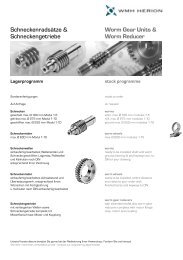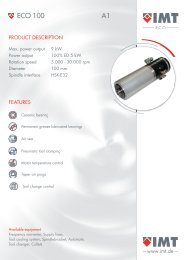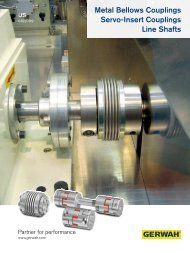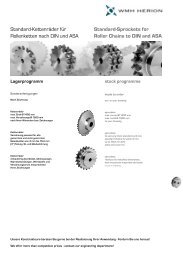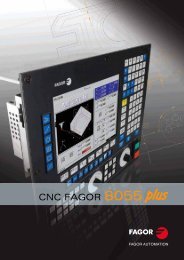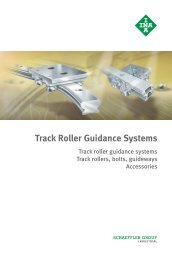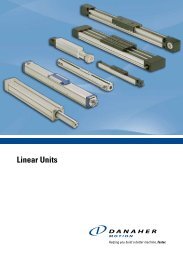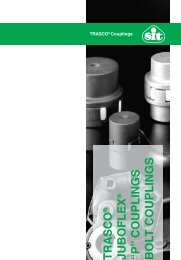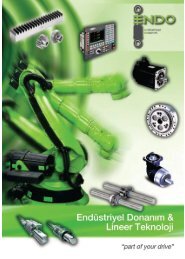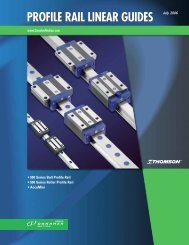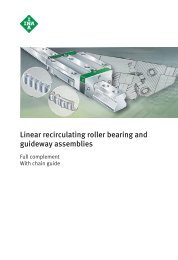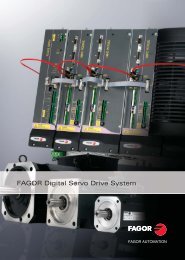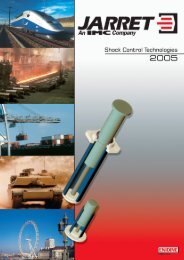slide guide
slide guide
slide guide
Create successful ePaper yourself
Turn your PDF publications into a flip-book with our unique Google optimized e-Paper software.
TOPBALL<br />
LIFE CALCULATION<br />
Since ball elements are used as the rolling element<br />
in the NB TOPBALL, the following equation is used<br />
to calculate the rated life.<br />
L: rated life (km) fH: hardness coefficient<br />
fT: temperature coefficient fC: contact coefficient<br />
fW: applied load coefficient (Table D-2)<br />
C: basic dynamic load rating (N) P: applied load (N)<br />
*Refer to page Eng-5 for the coefficients.<br />
Applied Load Coefficient (fW)<br />
When calculating the applied load, the weight of<br />
the mass, inertial force, moment resulting from<br />
the motion, and the variation with time should be<br />
accurately estimated. However, it is very difficult<br />
to accurately estimate the applied load due to the<br />
existence of numerous variables, including the start/<br />
stop conditions of the reciprocating motion and of the<br />
shock/vibration. Estimation is simplified by using the<br />
values given in Table D-2.<br />
If the stroke and number of cycles per unit time<br />
are constant, the life time is calculated using the<br />
following equation.<br />
L= (<br />
fH・f T・f C<br />
・ C fW P ) 3 ・50 Lh= L・10 3<br />
2・lS・n1・60<br />
Lh: life time (hr) ls: stroke length (m)<br />
L: rated life (km) n1: number of cycles per minute (cpm)<br />
Table D-2 Applied Load Coefficient<br />
operating conditions<br />
no shock/vibration<br />
15 m/min or less<br />
low shock/vibration<br />
60 m/min or less<br />
high shock/vibration<br />
90 m/min or less<br />
high shock/vibration<br />
180 m/min or less<br />
applied load<br />
coefficient fW<br />
1.0〜1.5<br />
1.5〜2.0<br />
2.0〜3.5<br />
3.5 or more<br />
Table D-4: Recommended Tolerance for Shaft Dia. and Housing Bore<br />
part<br />
number<br />
TK 8<br />
TK10<br />
TK12<br />
TK16<br />
TK20<br />
TK25<br />
TK30<br />
TK40<br />
TK50<br />
shaft dia.<br />
dr tol. (h6)<br />
mm μm<br />
8 0<br />
10 −9<br />
12 0<br />
16 −11<br />
20<br />
0<br />
25<br />
−13<br />
30<br />
40 0<br />
50 −16<br />
housing bore<br />
D tol. (H7)<br />
mm μm<br />
16 +18/0<br />
19<br />
+21<br />
22<br />
0<br />
26<br />
32<br />
+25<br />
40<br />
0<br />
47<br />
62 +30<br />
75 0<br />
Table D-5: Recommended Tolerance for Shaft Dia. and Housing Bore<br />
part<br />
number<br />
TW 3<br />
TW 4<br />
TW 6<br />
TW 8<br />
TW10<br />
TW12<br />
TW16<br />
TW20<br />
TW24<br />
TW32<br />
shaft dia.<br />
dr tol. (g6)<br />
inch inch<br />
.1875<br />
-.0002<br />
.2500<br />
-.0006<br />
.3750<br />
.5000 -.0002<br />
.6250 -.0007<br />
.7500 -.0003<br />
1.0000 -.0008<br />
1.2500 -.0004<br />
1.5000 -.0010<br />
2.0000 -.0004/-.0012<br />
housing bore<br />
D tol. (H7)<br />
inch inch<br />
.3750 +.0005/0<br />
.5000 +.0007<br />
.6250 0<br />
.8750 +.0008<br />
1.1250 0<br />
1.2500 +.0010<br />
1.5625 0<br />
2.0000<br />
+.0012<br />
2.3750<br />
0<br />
3.0000<br />
Mounting<br />
TK type TOPBALL is designed to be press fitted into the housing bore. When inserting bushing, however,<br />
don't apply excess force nor shock load which may cause permanent damage. For TW type TOPBALL,<br />
examples of mouting are shown in Figures D-3〜6 and D-8.<br />
Examples of Mounting<br />
Figures D-3 to D-8 illustrate mounting methods as example.<br />
Relation Between Ball Circuits and Load Rating<br />
The load rating of a <strong>slide</strong> bush varies according to<br />
the loaded positin on the circumference.<br />
The value in the dimension table indicates the<br />
lowest load rating with the load placed on top of one<br />
ball circuit.<br />
If the <strong>slide</strong> bush is used with two ball circuits loaded<br />
uniformly, the value will be greater.<br />
Table D-3 shows the load ratio for the number of<br />
ball circuits in each case.<br />
Table D-3 Optional Load Positions<br />
number of rows<br />
C<br />
(load rating<br />
specified on<br />
the table)<br />
Cmax<br />
(maximum<br />
load rating)<br />
load ratio<br />
Cmax/C<br />
4<br />
5<br />
6<br />
C C C<br />
1.414<br />
Cmax<br />
1.463<br />
Cmax<br />
1.280<br />
Cmax<br />
Figure D-3 Use of Holding Plates<br />
Figure D-6 Open Type<br />
Figure D-4 Clearance Adjustable Type<br />
Figure D-7 Press Fit (TK type)<br />
Figure D-5 Use of Retaining Rings<br />
Figure D-8 Pin Fixing<br />
TOPBALL<br />
MOUNTING<br />
A<br />
Clearance and Fit<br />
An appropriate clearance between TOPBALL and shaft is required in TOPBALL operation. Inadequate<br />
clearance may cause early failure and/or poor, rough movement. Proper clearance is determined by shaft<br />
diameter and housing bore. Table D-4 and D-5 show recommended tolerances of the shaft and housing bore.<br />
Shaft and Housing<br />
To optimize NB TOPBALL performance, high precision shafts and housings are required.<br />
1. Shaft: Dimensional tolerance, surface roughness and hardness greatly affect the traveling performance of<br />
the TOPBALL.<br />
The shaft must be manufactured to the following tolerances.<br />
A. Surface roughness of 0.4Ra or less.<br />
B. Hardness of 60 HRC or more (refer to page Eng-5).<br />
C. The proper tolerance of the shaft diameter is recommended on Table D-4 and D-5.<br />
The NB Shaft is an ideal component manufactured to meet these specifications. Please see pages F-1 ~<br />
for details.<br />
2. Housing: There are a wide range of designs and manufacturing techniques for housings. NB TOPBALL<br />
Units are available as standard products. When housings are prepared separately please refer to Table<br />
D-4 and D-5 for a proper fit.<br />
* SA type support rails are not<br />
compatible with the TOPBALL units.<br />
SPECIFICATION<br />
Anti-Corrosive Type<br />
A special TOPBALL is also available for anti-corrosive requirements. Please specify with a suffix "-SK" for either<br />
TOPBALL or TOPBALL Unit part number. The load plates are electroless nickel plated and balls are made of<br />
stainless steel.<br />
D-4 D-5<br />
magnified A<br />
* Please fix by the pin for open<br />
type housing .



